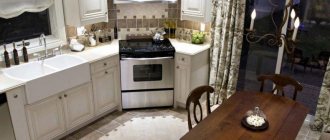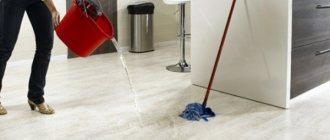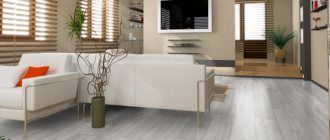The traditional floor covering for the kitchen is linoleum. It is practical to use and has a beautiful appearance. However, recently the trends have changed significantly, and many are resorting to using a combined solution consisting of tiles and laminate. We propose to understand what requirements are imposed on the floor covering in this case, what advantages the combined option has, and what solutions can be used as an idea for subsequent implementation
Requirements for a combined floor
When choosing a finishing material, attention is paid not only to its appearance, but to its technical characteristics. Subsequent operating conditions have a significant impact on the final result. Otherwise, the service life of the floor covering will be significantly limited.
When choosing tiles and laminate for the kitchen, you should make sure that the selected model has sufficient:
- mechanical strength and can withstand operational load;
- wear resistance, preventing the appearance of various defects on the surface;
- moisture resistance;
- practicality.
Attention! Considering the frequency of kitchen renovations, you should choose a model with a guaranteed service life of more than 10 years.
The selected floor covering should fit harmoniously into the interior of the kitchen. It should not be prone to the appearance of greasy stains: the top layer should be easy to wash off. Models that allow the use of special stain removers are preferred.
Combination ideas in different interior styles
In the minimalist style, a more restrained finish is assumed with rather modest and laconic color schemes, in gray, black or white colors; for the high-tech direction, choose a combination of glossy ceramic tiles with laminate boards in dark gray, black, anthracite or wenge shade.
Scandinavian design can be decorated using light tile finishes or models with imitation wood, stone or marble, which, in combination with beige, white, limestone or ivory laminate, will have a pristine and natural appearance.
The photo shows a Scandinavian-style hallway with a floor lined with patterned hexagonal tiles combined with beige laminate boards.
In rustic country, they often use laminate fabric in walnut, red, rich brown or beige shades in combination with multi-colored mosaics or patterned ceramics in the patchwork style, and for an industrial loft they prefer laminate that has a shabby and aged look in combination with dark tile cladding or products that imitate brick.
The photo shows a laminate floor combined with patchwork tiles laid in the center in a country-style kitchen interior.
Pros and cons of tiles and laminate in the kitchen
Installing laminate flooring alone or just tiles in the kitchen is fraught with certain difficulties. The first one quickly loses its original appearance. Tiles without special heating remain quite cold and uncomfortable. By laying combined flooring, you can immediately solve several problems. Successful:
- create a safe sanitary zone near the kitchen unit, which even the most durable and high-quality laminate cannot create. In terms of strength indicators, tiles are two orders of magnitude superior to laminated panels;
- prevent possible swelling of the floor covering when water flows under the kitchen cabinet. The tile retains its geometric shape during prolonged contact with water, unlike laminate, which swells, losing its appearance and shape;
- prevent the surface of the floor covering from being pressed under the influence of the load created by the metal supports of the kitchen unit. When laying laminate flooring, it is not possible to avoid such a problem. A layer of PVC or pressed paper is pressed through quite easily;
- lay comfortable and practical laminate flooring over almost the entire kitchen area;
- visually divide the flooring into separate zones, designating a work area for preparing lunch and a dining room for eating;
- optimize repair costs without sacrificing the practicality and functionality of the flooring;
- Make it easier to keep your kitchen clean.
Despite a number of obvious advantages, this option also has some disadvantages. Careful consideration must be given to the design of the flooring so that the materials look beautiful next to each other. Otherwise, there will be a feeling of some incompleteness.
Attention! A perfect combination of two different materials can only be achieved through proper selection of their color, texture and color.
About methods of laying floor tiles
Even simple plain tiles can be laid in different ways. Let's get acquainted with common installation methods.
- "Carpet". The method involves combining elements of different patterns and sizes. Here you need to be very careful not to overdo it and make the room tasteless.
- Flat straight.
- Modular installation. It also combines tiles of several sizes/shapes.
- "In a running start." This type of installation is also called deck installation and is used for rectangular shapes.
- "Herringbone". We are talking about parquet installation, which is characterized by classic chic and is used for narrow rectangular tiles.
Transitions
The junctions between laminate and tiles should be properly designed. Only in this case will the laid floor covering have a finished appearance. This can be done with or without a threshold.
Without threshold
If you decide to abandon the threshold, the following will help to design the transition beautifully:
- cork compensator;
- liquid plug.
In the first case, a strip of cork is glued at the junction of the tiles and the laminate. The laminated panel at the junction must be impregnated with a composition that protects against moisture. Cork material is classified as environmentally friendly. Has a long service life. This makes it possible to use it when decorating any room, including the kitchen.
Attention! The choice in favor of a cork compensator should be made only if the height of the tiles and laminate is comparable. Otherwise, the opposite effect will be obtained.
The method can be used in the presence of straight and curved transitions. To enhance the effect, you should use a cork expansion joint with a designed top layer. The protective varnish, paint, and veneer look beautiful.
Liquid cork is a mixture based on cork chips and glue. Thanks to its thoughtful composition, the connection point is not afraid of significant temperature fluctuations and mechanical stress. Due to this, the liquid cork option is preferable to using a cork compensator. The prepared mixture is rubbed into the space separating the tile and laminate.
We use the threshold
If you don’t want to bother with the cork layer or liquid mixture, you can use a special threshold. In this case, the installation process is greatly simplified. Manufacturers offer ready-made thresholds of various widths and configurations. Can choose:
- straight with the same thickness of the laid laminate and tiles;
- angular, if the difference in height exceeds 5 mm and you want to create a smoother transition;
- bendable if the joint has the shape of a curved line.
In addition to the shape, when choosing a threshold, you should pay attention to the material from which it is made. Manufacturers offer:
- Vinyl. Allows you to design curved joints, ensure a smooth transition between single-level surfaces, and beautifully design a junction that has different finishing heights. Plastic thresholds consist of a base and a decorative nozzle. They allow you to level out height differences within 8 – 9mm. Flexible elements are easily transformed and take the required shape. A wide color palette allows you to choose the best option for any design solution;
- Aluminum. A fairly rigid element that helps to level out differences in height and hide minor problems that appear after the completion of finishing work. Manufacturers offer products with a special coating applied to the surface. The installation procedure for the aluminum threshold may vary slightly. They produce products with already cut holes for screws. There are powders with a hidden method of fastening and glued to the base using a special self-adhesive.
A wide selection of colors, standard sizes and configurations allows you to select the optimal threshold for a specific transition.
Material selection
First you need to decide on the material from which the flooring is made.
Ceramics. It is based on fired clay. On the shelves of construction stores you can find ceramics of various designs and textures. Ceramic tiles are wear-resistant and convenient for creating design elements - ornaments, panels. Disadvantages include high fragility and thermal conductivity compared to other materials.
Porcelain tiles. This coating is obtained from a mixture of two types of clay and granite chips. During the manufacturing process, the mixture is exposed to high temperatures and pressure. The advantages are high strength and high-quality design. Disadvantages - high price.
Quartz vinyl. This is a composition based on high quality quartz sand with the addition of pigments, stabilizers and vinyl. The latter makes the tile durable, flexible and wear-resistant.
The choice of floor color usually dictates the area and design of the room, as well as the tastes of its occupants. There is an opinion that the tiles in the hallway and in the kitchen should be the same. This is the simplest and most win-win solution, but you can always experiment and create your own atmosphere in each room.
A pastel-colored floor can add light to a darkened room and visually expand the room.
A dark floor will look good in a spacious room, setting off light furniture. For a kitchen in a classic style, a coating that imitates natural stone is suitable.
Tiles that imitate wood or parquet will fit perfectly into the interior of a small kitchenette.
And the floor of a country-style kitchen can be decorated with tile inserts with a pattern or design.
The most popular colors for decorating kitchens and hallways are beige, gray and brown.
Black and white tiles are used much less often, since every speck and every stain after washing the floor catches the eye. Glossy ceramics create the same effect.
This is another reason why a rough surface finish is more appropriate in the kitchen and hallway.
When choosing shapes and sizes, they most often focus on the area of the room: the larger the room, the larger the tiles should be.
There is another approach to choosing the shape and size of ceramics: give preference to those tiles that require less cutting when laying. This allows you to save both money when purchasing material and time spent on work.
Now you can buy products of standard sizes (30x30 cm, 20x30 cm, 20x25 cm, 20x20 cm, 10x15 cm, 10x10 cm) and larger tiles (40x40 cm, 60x100 cm, 70x120 cm).
The floor in the hallway and kitchen is often contaminated with sand and melted snow, subject to impacts and impact from heels. Therefore, the coating must meet certain technical characteristics:
- Water resistance - below 3%.
- Friction coefficient - no more than 0.75%.
- Wear resistance class - no less than PEI 3.
- Safety category - 9-10.
- Hardness index - from five units.
- Chemical resistance - class AA or A.
- Variety - first. Among first grade products there is the smallest amount (5%) of defects.
The leaders in tile production are Spanish and Italian companies.
Grouting joints
If the tiles and laminate are located at the same height and the gap between them is minimal, instead of using special layers and thresholds, you can try to rub the joint with a special compound. The butt-to-butt method allows you to implement:
- Sealant. Depending on the size of the gap and the desired effect, you can choose a transparent composition or give preference to a colored material;
- Conventional construction foam;
- Special grouting paste, available in a wide range of colors;
- Fugue for tiles;
- Liquid plug described above.
The characteristics of the listed compositions may differ significantly. When choosing the appropriate option, you should make sure that they have sufficient adhesion to the surface of the tiles and laminate. Otherwise, the desired effect will not be achieved.
Linoleum
Photo report from a classic kitchen with linoleum tiles
Pros:
- Wide variety of colors.
- The most budget-friendly flooring material. This is especially true if you just want to freshen up the kitchen or do some minor cosmetic repairs.
- Easy installation. It is possible to lay linoleum yourself even without any construction skills.
- Easy to care for. No impregnation or special detergents are required - it is enough to carry out wet cleaning in a timely manner.
- Nice surface. Linoleum is a fairly warm material, and it is also quite soft and elastic. Plates and cups that fall on the floor “survive” much more often.
Minuses:
- If the kitchen is located on the sunny side, then after a few years the sunny areas will fade noticeably.
- A dropped knife or any other sharp object, or corners of furniture, can damage the surface.
- Risk of stains. Grease, aggressive detergents, paint and similar substances can leave stains on linoleum. The main thing in such cases is to wipe the stain in time.
- Neglected linoleum is quite difficult to clean.
DIY installation features
Despite the apparent complexity, most of the finishing work in your home can be done on your own if desired. Laying a combined floor with your own hands is no exception. There are some installation features that you should familiarize yourself with in advance. This will allow you to avoid common mistakes and help you complete the planned amount of work efficiently.
To achieve a high-quality result, you should initially try to bring part of the floor surface, decorated with laminate, and the second part, covered with tiles, to the same level. To do this, before you start laying the tiles, you need to know exactly which laminated panels will be laid and how thick the backing will be.
If the difference is small and the tiles are thicker, the existing height difference can be compensated for using tile adhesive. Apply a layer of sufficient thickness and then lay the selected finishing material. Otherwise, you will need to fill the self-leveling unit to level the surface and compensate for the difference in height.
When starting to lay laminate flooring, you should pay special attention to the instructions provided by the manufacturer. It describes in detail the procedure and also indicates the need for compensating gaps between the wall and the floor surface to be laid. At the junction of the laminated panels and tiles, we cut off part of the backing and film, leaving about 10 cm of the base uncovered. We cut the laminated panels to size and check the quality of the joint. Remove the outermost row and put it aside.
We fix the outer row of the laminate using a plastic adhesive composition that has good adhesion to both types of flooring and has sufficient plasticity. Apply the prepared composition to the previously cleared substrate.
On the applied adhesive composition we lay the previously adjusted to size outer row. When laying laminated panels, we ensure the formation of an equal gap between the tiles and the laminate. To obtain the desired result and simplify the work, special devices are used.
After a day, after waiting for the adhesive composition to dry completely, the joint venture can be removed. As a result, a perfectly flat surface is formed between the tiles and the laminate.
We fill the gap between the tiles and the laminate with a sealing compound. It is advisable to choose a sealant whose color is close to the installed floor covering. We ensure high-quality filling of the space between layers.
We level the sealing compound and remove its excess using a special device. If desired, it can be placed at an angle and form a beautiful chamfer at the transition point of the laminate to the tile. We constantly dip a rubber spatula into the soap solution to prevent streaks from appearing on the floor surface.
This should be done as often as possible in order to get a quality result in the end.
If you decide to use a threshold to design the transition, the work will be performed slightly differently. In this case, it is not necessary to align the mating surfaces in the same plane. We invite you to watch a video that will help you get high-quality results without much effort:
The method for forming a non-standard joint is presented in the following video:
Cork
Pros:
- Tactilely, a cork floor is very warm, so there is no need to make a warm floor.
- Cork muffles the sounds of footsteps well, so if your neighbors complain about your loud stomping, the cork will put an end to these complaints. Cork is definitely better than other materials in this regard.
- Easy to care for. Cork does not require special cleaning compounds, etc. – it is enough to wipe the floor with a wet cloth and vacuum in a timely manner.
- Durability. A properly installed cork floor can last more than 10 years.
- Elasticity and softness. These properties are especially relevant if you have children. In addition, the risk of breaking a cup or plate is significantly reduced.
Flaws:
- High price. High-quality cork will cost more than laminate, not to mention linoleum - especially if you add installation services and the purchase of related consumables to the cost.
- Poor tolerance to high humidity. Frequent exposure to water and humidity can cause the cork to simply swell.
- Fear of sharp objects. Metal chair legs, pet claws and sharp corners can damage the cork.
- Difficulty in installation. The base under the cork must be almost perfectly level, and the installation itself will require either certain skills or calling a specialist.
Combination with furniture
When working on the design of a combined floor surface, you should make sure that the color of the laminate and tiles will combine favorably with the colors of the furniture facade. It is worth choosing the optimal color scheme before the main repair work begins.
There are no special problems if the kitchen furniture is made in light colors. Almost all colors of floor coverings can be combined with a set in white, cream or beige. The main thing is to give preference to warm tones. For the rest of the floor I choose red-brown or dark colors. This combination looks the most advantageous.
If you prefer a kitchen set in dark colors, you will have to perform a color division. To do this, the dark facade is complemented with contrasting apron cladding or most of the wall is made light. Light tiles on the wall and floor of the room go well with each other and dark kitchen cabinets. The latter is complemented with a chocolate-colored laminate. The upper tier of wall cabinets in this case can make the overall impression heavier. In most cases, their installation is refused.
If the kitchen has large enough windows and the walls and ceiling are made in light colors, dark furniture is complemented with brown laminate, combined with light tiles. With this combination, the part of the floor surface covered with tiles looks wider, visually expanding the boundaries of the kitchen space.
Porcelain tiles
Porcelain tiles are quite similar to tiles, so their pros and cons are the same. Which one is better and which is worse is a controversial issue, so you should focus on price and design.
Advantages:
- Moisture resistance
- Wear resistance.
- Easy to clean.
Flaws:
- Installation difficulties
- Breakable dishes
- It is advisable to install heated floors
- The seams will collect dirt
This is how seams become dirty after long use.
Design Tips
Many designers use the combined option. This is a good opportunity for zoning space. Apartment owners are attracted by the possibility of simplifying the care of the floor surface.
When choosing a material, you should focus on the combination of shape, color scheme, and overall stylistic design. To make different materials look harmonious next to each other, you should choose tiles and laminate of the same color, but in different shades. The difference should be one tone. What will be lighter: tiles or laminated panels is not so important.
For a better combination, it is worth making one part of the finish more expressive, and let the other instead of the background. Some designers combine glossy and matte tiles of different sizes. Laminate is chosen with the simplest design to obtain maximum effect.
Hexagonal tiles look stylish and unusual. This is a good opportunity for zoning space. Thanks to the non-standard shape, it is possible to create a unique transition along a broken line between two types of flooring. In some cases, standard tiles are used, but they vary with different installation methods. You can choose longitudinal, transverse, diagonal. Lay in a herringbone or checkerboard pattern.
The imitation of various materials deserves special attention. If you are laying tiles with the texture of textiles, leather, or marble stone, choosing a darker laminate will add nobility to the floor surface. A good option for a kitchen decorated in a modern style is laminate, complemented by multi-colored honeycomb-shaped tiles.
Materials of the same tone allow you to give the interior a laconic appearance. However, a competent choice of contrasting shades will make it no less harmonious. To smooth out the situation, some use a combination of white and beige.
When working on the design, it is worth paying attention not only to the color combination, but also to the shape of the line along which the laminated panels adhere to the tiles. She may be:
- straight, curved or rounded shape;
- without threshold or with curb;
- at the same or different heights.
When choosing the shape of the joint, the following rules should be taken into account:
- the form must fully comply with the chosen style concept. If regular geometric shapes predominate in the interior due to rectangular cabinets and a square table, it is worth making the transition in a straight line;
- a connection along a wavy line is completely justified if there is a similar line on pieces of furniture and the design of other surfaces. A wavy line may be present in the design of a cabinet or ceiling surface;
- It is easier to form a transition along a zigzag line if the laminate is laid in a checkerboard pattern.
Thus, the correct selection of design will help to correctly delimit the space in the kitchen, add coziness, and help make it more spacious and bright. Attention should be paid not only to color, but also to texture and installation method. With this approach, even a small kitchenette can turn into a large, bright room.
Tree
Pros:
- No “wood” imitation can compare with the look of real wood.
- Environmentally friendly material.
- Retains heat well
Minuses:
- Quite a high cost.
- With high humidity or constant changes, a wooden floor can swell and begin to creak.
- Laying is a rather expensive and labor-intensive process. The wooden floor is placed on logs, which must first be leveled in height. If the apartment has low ceilings, then the logs will reduce the already small height of the room.
- Natural wood is quite susceptible to falling objects and dragging them across the floor - over time, dents and scratches may appear. In this case, you will have to spend additional money on sanding, varnishing, etc.
Question 5: How to care
Now let's figure out how to clean the linoleum in the kitchen from various contaminants.
- How to wash a linoleum-covered floor during everyday cleaning?
Warm water with a small amount of washing powder. You will have to wash it twice; For the second pass, use a semi-dry cloth and clean water.
- How to clean old linoleum from stubborn dirt?
Apply “Whiteness” to its surface - a solution of sodium hypochlorite or any other chlorine-containing bleach and rinse with water after 15 minutes. Repeat treatment if necessary.
“Whiteness” will remove stubborn dirt from the floor in 10-15 minutes.
- How to remove grease from kitchen flooring?
Any non-abrasive dishwashing detergent or washing powder.
- How to clean the floor from spilled greenery?
Alcohol and paper napkins.
To avoid smearing the brilliant green, move from the periphery to the center of the spot.
Such stains can be removed with pure ethyl alcohol.
- How to clean a floor stained with iodine and coffee?
A rag soaked in gasoline or turpentine.
Question 4: how to lay
Preparing the foundation
The base should be:
- Smooth : on potholes or hillocks, linoleum is easy to break through;
- Clean . The debris remaining under the coating will create bumps on its surface;
- Durable . A sagging floorboard will again cause a rupture of the covering under the furniture leg.
Here are ways to prepare your floor for linoleum installation for concrete and wood floors.
| Image | Description |
| Concrete floor, large unevenness : a leveling screed is laid along the base along the beacons. Thickness - from 50 mm, reinforcement is required. | |
| Concrete floor, minor unevenness : filled with self-leveling mixture. The base must be pre-primed with penetrating soil. The cement-polymer mixture is dispersed over the surface with a needle roller. | |
| Plank floor : leveled with plywood with a thickness of 10 mm. The floorboards are pre-attached to the joists with self-tapping screws, and the humps are removed by scraping. |
Laying linoleum
Linoleum is spread over the floor surface and kept for 2-3 days without trimming along the walls. Pre-laying will allow you to get rid of waves on its surface. Then the cutting lines are marked and the covering is cut off with a sharp knife; inevitable trimming errors will hide the baseboards.
Trimming the covering adjacent to the wall.
Adjacent strips are glued from the back with double-sided adhesive tape.
Double-sided tape for polypropylene linoleum.
Let me answer a couple of typical questions about coating installation.
- Is it possible to put linoleum on linoleum?
If the bottom layer does not have wrinkles or folds, of course you can.
- How to glue the edges of linoleum strips with felt insulation?
Cold welding for PVC coverings. It is inserted into the seam using the supplied needle. While the glue is setting, the strips are fixed with masking tape.
Cold welding for gluing linoleum strips.
Variety of colors
After choosing the material and type of linoleum, you can begin to select the color scheme and texture. After all, the wrong floor can not only complicate operation, but also spoil the overall perception of the interior and make staying in the living room uncomfortable.
In the interior of the living room, you can use a variety of options for both light and dark coatings. Read general recommendations from experts.
Dark shades of the floor are practical; dirt is not so noticeable on them. However, you should carefully use rich browns and grays if there is a lack of light in the room. Thus, if the window of the hall faces north, then it is better to abandon dark linoleum in favor of a light option.











